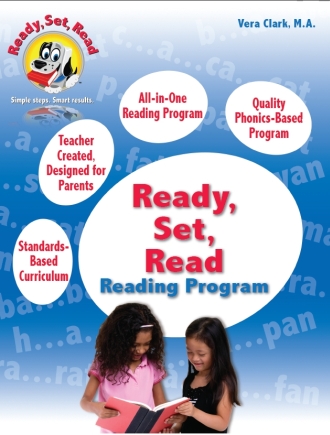You can use the Ready, Set, Read Reading Program to teach anyone to read—babies through adults. It divides the process into three steps: learning letters and their sounds, learning to blend, and working through the reading lessons to learn all the different phonograms. Phonics “rules” are taught as explanations rather than as something students must memorize. Extensive practice with words that fit each “rule” helps students to learn through application and practice.
Everything you need is contained in one 280-page book. Flashcards on pages at the back of the book can be used as is, or copied on to card stock or laminated. They are also available free on the publisher's website at: http://readysetreadnow.com/ABCFlashCards.pdf. Flashcards have both upper and lower case letters on one side and an animal drawing of a key word on the reverse. These are used to introduce letters, primary sounds of consonants, and the short vowel sounds.
Blending, the second step, is taught by using word families, beginning with “cat, rat, bat, sat, fat, hat, mat,” and “pat.” Both the first and second steps are presented at whatever pace works best for the learner. The author, Vera Clark, has taught infants younger than a year old! Obviously, you will move at a much slower pace if you are teaching infants than you will if you are teaching a seven-year-old.
Once through the first two steps, students are ready to begin the actual lessons. The 100 lessons should take no more than fifteen minutes per day to complete. If you are teaching preschoolers, take as long on each lesson as it takes for a student to master it. A reproducible record-keeping chart may be used to track student progress as they master each lesson.
The first ten lessons have three pages each with detailed instructions. After that, lessons have only two pages with minimal instructions. The new phonogram or phonograms are shown at the top of each lesson. A box then lists new vocabulary words with a separate list for sight words to be learned. Students will practice those words then practice reading the fifteen to twenty sentences that follow. The first lesson has sentences such as, “The man is tan” while the final lesson has sentences such as “Mr. Henderson is frustrated with the demands of his boss, and it shows in his facial expressions.” Vocabulary and sight words in the final lesson include “superficial, palatial, conceptual, fiasco,” and “archeology.” You can see that there is a huge progression from the first to the last lesson, and you would not expect to complete all lessons with a kindergartner. However, you might complete most of the lessons with a first grader—possibly up through the first 80 lessons. You could save the final group of lessons for second grade or later. If you are using Ready, Set, Read for remedial instruction, the student might well complete all of the lessons in a short time.
Instruction for the first ten lessons includes mention of ending punctuation, possession shown by apostophes, plurals, commas, and rhyming words. Later lessons address suffixes and contractions. A cartoon illustration accompanies each lesson. The student is supposed to identify which sentence describes each illustration. This requires some thought and discernment and might sometimes be difficult for young children.
Optional activities are presented at the back of the book. These include vocabulary building, reading comprehension, writing development, and spelling. This program might also be used to teach spelling for children who are old enough. While it doesn't teach handwriting, you might use the lesson content for handwriting practice while relying on another resource for actual instruction in letter formation.
You can use this book on its own, but most children will need lots of practice in the early stages. They can re-read the words and sentences in the book. Those needing more practice and who prefer colorful books might want to use the new Illustrated Lessons Series books, a series of readers that correlate with the lessons. Only the first five of these readers are available as I write this review, but others are in development. Pages have full-color pictures illustrating the practice sentences. Other phonetic readers that begin with short-vowel words and use word families will also work.









